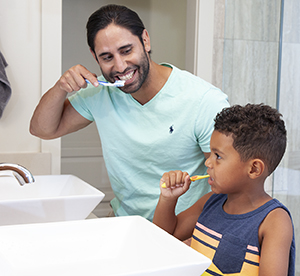Brushing and Toothpaste
The importance of brushing
The single best way to remove harmful plaque from teeth and gums is to brush teeth regularly and correctly. Plaque is a thin, sticky film loaded with bacteria.
What is the correct way to brush teeth?
Every mouth is different, and there is more than one effective way to brush. Deciding which way is best for you depends largely on your teeth position and gum condition. Talk with your dentist to decide which brushing method is best for your mouth.
Generally, dentists recommend the following method:
-
Place the toothbrush next to your teeth with the bristles pointed at the gums at a 45° angle.
-
Gently brush back and forth using short, tooth-wide strokes. Use vertical up and down strokes to brush the inside surfaces of the front teeth.
-
Brush the outside of the teeth, inside of the teeth, and the chewing surfaces.
-
Gently brush the tongue to remove bacteria and freshen breath.
-
Repeat steps 1 through 4 at least twice daily, especially after meals and snacks.
What type of toothbrush should be used?
A toothbrush head should be small—about 1 inch by 1/2 inch—and should have a handle suitable for firm grasping. The bristles of the brush should be soft, nylon, and rounded at the ends. This helps make sure that the brush bristles are gentle to the gums and tooth surfaces. Soft, polished bristles allow you to reach into the crevice between the teeth and gums to remove plaque without damaging the gums. Some brushes are too abrasive and can wear down tooth enamel. So in most cases, medium and hard bristles are not recommended. Only gentle pressure is needed when brushing to remove the plaque. Too much pressure can cause the gums to recede and can wear away the tooth surface.
The American Dental Association (ADA) says that both manual and power toothbrushes work well. The most important thing is that you brush correctly for at least 2 minutes at least twice a day. Ask your dentist if they recommend a manual or power toothbrush for you.
How often is brushing needed?
Generally, brushing is recommended twice a day for at least 2 minutes each time. People often think they are brushing long enough. But in fact, most people spend less than 1 minute brushing. In addition, it is generally better to brush 2 minutes twice a day instead of brushing quickly 5 or more times throughout the day.
Dentists advise brushing your teeth during the day while at work, school, or play. Keeping a toothbrush handy—in your desk or backpack—increases the chance that you will brush during the day. Replace your toothbrush every3 to 4 months, or sooner if the bristles are fraying or damaged.
What is toothpaste?
Toothpaste helps clean your teeth. Toothpaste may include the following ingredients:
-
Fluoride to strengthen tooth enamel
-
Desensitizing ingredients to reduce tooth sensitivity
-
Anti-cavity ingredients to prevent cavities
-
Flavoring and noncaloric sweeteners. Sugar is not in any ADA-approved toothpastes.
-
Peroxide to lighten stains
Facts about toothpaste
Brushing with toothpaste, especially one that has fluoride, helps to:
-
Remove plaque.
-
Resist decay.
-
Help strengthen the enamel that has been attacked by acids.
-
Clean and polish teeth.
-
Remove teeth stains.
-
Freshen breath.
Which type of toothpaste is best?
Fluoride is the most important ingredient in toothpaste. As long as the toothpaste contains fluoride, the brand or type (paste, gel, or powder) generally does not matter. All fluoride toothpastes work effectively to fight plaque and cavities, and clean and polish tooth enamel. The brand you choose should have the ADA seal of approval on the container. This means that controlled, clinical trials have shown enough evidence the product is safe and effective.
Some toothpastes offer tartar control pyrophosphates to prevent the buildup of hard calculus deposits on teeth. Others offer whitening formulas to safely remove stains, making teeth brighter and shinier. Certain toothpastes are made for sensitive teeth. But fluoride is the true active ingredient that works the hardest to protect your teeth. Talk with your dentist if you have questions about which toothpaste is best for you.
Medical Reviewers:
- Daphne Pierce-Smith RN MSN
- Rita Sather RN
